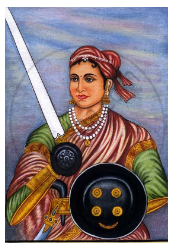Advertisements
Advertisements
Question
| The Indian Rebellion of 1857 was a major uprising against the rule of the British East India Company, which functioned as a sovereign power on behalf of the British Crown. With reference to this, answer the following question: |
The India army was reorganised after 1858, to prevent the reoccurrence of another uprising. Analyse this statement by stating any four changes made in the army after the Revolt.
Solution
- The strength of European troops in India was increased. The ratio of European to Indian troops was fixed at 1 : 2 (Bengal army) and 2 : 5 (Madras and Bombay armies). Practically the same ratio was maintained till the First World War. The general principle adopted was that the number of Indian sepoys should not exceed twice that of the European troops.
- European troops were kept in key geographical and military positions.
- To desist the Indian soldiers from rising again against British rule, the sophisticated weapons and ammunition were never placed under the charge of Indians. All Indian artillery units, with the exception of a few mountain units, were disbanded.
- Discrimination on the basis of caste, region and religion was practised in the recruitment to the army.
- In order to discourage nationalism, measures such as the introduction of caste and community in most regiments were taken.
- Newspapers, journals and nationalist publications were prevented from reaching the soldiers to keep the Indian army separated from the life of the rest of the population.
Notes
Students should refer to the answer according to their questions.
APPEARS IN
RELATED QUESTIONS
Answer the following question briefly:
In the context of the Revolt of 1857, briefly discuss:
Any four results of the Revolt of 1857
This is the picture of the queen who led the Revolt in Central India.

What was the major outcome of the Revolt of 1857?
Give a reason why:
State of Awadh was annexed by the British.
The Revolt of 1857 was the beginning of the independence struggle against the colonial rule of the British. With reference to the consequences of the Revolt, answer the following:
Mention any three changes made in the administration with the end of the Company's Rule.
| The Indian Rebellion of 1857 was a major uprising against the rule of the British East India Company, which functioned as a sovereign power on behalf of the British Crown. With reference to this, answer the following question: |
How did the failure of this Revolt impact the Mughals and the Peshwas?
Which of the following was the result of the Great Uprising of 1857?
Under the Government of India Act 1858, who gave up the direct administration of India?
State any two consequences of the disbanding of the armies of the annexed States by the British.
What impact did the Uprising of 1857 have on the Peshwaship?
The Great Outbreak of 1857 brought about important changes in the character of Indian administration and the future development of the country In this context, discuss:
- The changes introduced in the administrative set-up of the British territories in India.
- The changes in the Army.
- The changes in the relationship with the Princely States.
